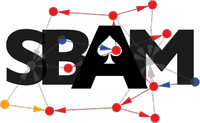Contents
BitDew
The BitDew framework is a programmable environment for management and distribution of data for Grid, Desktop Grid and Cloud Systems.
 BitDew is a subsystem which can be easily integrated into large scale computational systems (XtremWeb, BOINC, Hadoop, Condor, Glite, Unicore etc.). Our approach is to break the “data wall” by providing in a single package the key P2P technologies (DHT, BitTorrent) and high-level programming interfaces. We first target Desktop Grid with petascale data system: up to 1K files/nodes, with size up to 1GB and distributed to 10K to 100K nodes. The BitDew framework will enable the support for data-intense parameter sweep applications, long-running applications which requires distributed checkpoint services, workflow applications and maybe in the future soft-realtime and stream processing applications.
BitDew is a subsystem which can be easily integrated into large scale computational systems (XtremWeb, BOINC, Hadoop, Condor, Glite, Unicore etc.). Our approach is to break the “data wall” by providing in a single package the key P2P technologies (DHT, BitTorrent) and high-level programming interfaces. We first target Desktop Grid with petascale data system: up to 1K files/nodes, with size up to 1GB and distributed to 10K to 100K nodes. The BitDew framework will enable the support for data-intense parameter sweep applications, long-running applications which requires distributed checkpoint services, workflow applications and maybe in the future soft-realtime and stream processing applications.
See more on BitDew website.
Pilgrim
Pilgrim, a system / network / applicative metrology and performance prediction framework.
 Pilgrim is an open metrology and prediction performance framework whose goal is to provide easy and powerful tools for instrumenting computer platforms and predicting their behaviour. Those tools are aimed at being used not only by humans but also by other programs, in particular by resource managers and schedulers. Pilgrim is designed to be a loosely coupled integration of various custom-developed or off-the-shelf tools.
Pilgrim is an open metrology and prediction performance framework whose goal is to provide easy and powerful tools for instrumenting computer platforms and predicting their behaviour. Those tools are aimed at being used not only by humans but also by other programs, in particular by resource managers and schedulers. Pilgrim is designed to be a loosely coupled integration of various custom-developed or off-the-shelf tools.
See more on Pilgrim website.
Sam4C
Security-Aware Models for Clouds Graphical Tool
 Sam4C -Security-Aware Models for Clouds- is a graphical and textual editor to model Cloud applications (as virtual machines, processes, files and communications) and describe its security policy. Sam4C is suitable to represent any static application without deadline or execution time such as n-tiers or parallel applications. This editor is generated in Java from an EMF -Eclipse Modeling Framework- metamodel to simplify any modifications or extensions. The application model and the associated security policy are compiled in a single XML file which serves as input for an external Cloud security-aware scheduler. Alongside with this editor, Cloud architecture models and provisioning algorithms are provided for simulation (in the current version) or real deployments (in future versions). The design of Sam4c is the result of join effort with ENSIB (Bourges).
Sam4C -Security-Aware Models for Clouds- is a graphical and textual editor to model Cloud applications (as virtual machines, processes, files and communications) and describe its security policy. Sam4C is suitable to represent any static application without deadline or execution time such as n-tiers or parallel applications. This editor is generated in Java from an EMF -Eclipse Modeling Framework- metamodel to simplify any modifications or extensions. The application model and the associated security policy are compiled in a single XML file which serves as input for an external Cloud security-aware scheduler. Alongside with this editor, Cloud architecture models and provisioning algorithms are provided for simulation (in the current version) or real deployments (in future versions). The design of Sam4c is the result of join effort with ENSIB (Bourges).
See more on Sam4C website.
SBAM
SBAM is a middleware for resource discovery in a very large environment

SBAM is the middleware directly coming from results of the ANR project SPADES. Sbam initiates a non-intrusive, but highly dynamic environment able to take advantages of available resources without disturbing their native mechanism. SBAM federates multisite resources in order to schedule, submit and compute users’ tasks in a transparent way.
See more on SBAM website.
SpeQuloS
Quality Of Service for Best Effort Distributed Computing Infrastructures with Cloud resources
SpeQuloS provides Quality Of Service (QoS) to Desktop Grids or other “best effort” Distributed Computing Infrastructures (DCI) by supplying resources from Cloud computing.
 Desktop Grids (DG) are DCIs made of regular computers, and consequently, are much less reliable than other Grids. For example, in volunteer computing projects such SETI@home, participants may leave the infrastructure at any moment. It is therefore impossible to provide QoS features to DG users, such as jobs completion time prediction. SpeQuloS aims to solve this situation by dynamically provision resources from Cloud computing to support DGs operation. SpeQuloS can instantiate “Cloudworkers” from various Cloud systems to participate to DG computation. SpeQuloS also monitors DG activity and provides QoS information to users.
Desktop Grids (DG) are DCIs made of regular computers, and consequently, are much less reliable than other Grids. For example, in volunteer computing projects such SETI@home, participants may leave the infrastructure at any moment. It is therefore impossible to provide QoS features to DG users, such as jobs completion time prediction. SpeQuloS aims to solve this situation by dynamically provision resources from Cloud computing to support DGs operation. SpeQuloS can instantiate “Cloudworkers” from various Cloud systems to participate to DG computation. SpeQuloS also monitors DG activity and provides QoS information to users.
SpeQuloS development takes place in the European Desktop Grid Infrastructure (EDGI) project.
See more on SpeQuloS website.
